Time flies when your little one is growing up and achieving milestones every week! Your baby is the centre of attraction at home at this point. She might be waving, gurgling, gabbling, moving her hands and legs, nodding, and smiling. Although it’s a joy to see your baby learning and acquiring new skills, you must be aware of the milestones for her age and you might be keeping an eye on your baby’s development. Playing with her, encouraging her, appreciating her, and connecting with her will help immensely in her brain development. So, remember that your love, touch, attention and time are vital at this stage. Development is enhanced by your involvement, and it revolves around parent-child interaction.
What to Expect From Your 6-Month-Old Baby
Six-month-old babies are interested in everything around them. Every little thing is exciting to them, and it leads them to learn something new every day. You can see them starting to chew on objects, take objects and handle them in their own way, roll over and sit up without anyone’s support. At this stage, your baby will have developed motor skills such as:
- Rolling on her back
- Sliding back and forth using her tummy
- Rising on her knees, and rocking back and forth
Your baby is ready to explore movement-related activities and interactive activities at this stage. Aside from this, your baby’s eye colour is now developed, and her speech patterns are developing. Babies at 6 months begin to grasp the languages they hear.
All of the activities that your growing baby will love at this stage will help in stimulating her physical development, social skill development, and mental and emotional development. Your baby will enjoy experiencing different sensations, which will impact her overall development.
In short, your baby is observing, imitating and having fun, but also acquiring new skills. At this stage, your baby will be on an exploring spree.
Learning Activities for a 6-Month-Old Baby
Your baby will be crawling and walking around to explore the environment around her, so it’s important to play with her and introduce her to various interactive activities in order to enhance her physical, mental, emotional, and social development. Get creative with your baby during playtime – here are some six-month-old baby activities that will help your infant boost her overall development.
1. Reading
It’s a great time to start reading books to your baby! Go for colourful picture books and books with tactile components to keep her engaged.
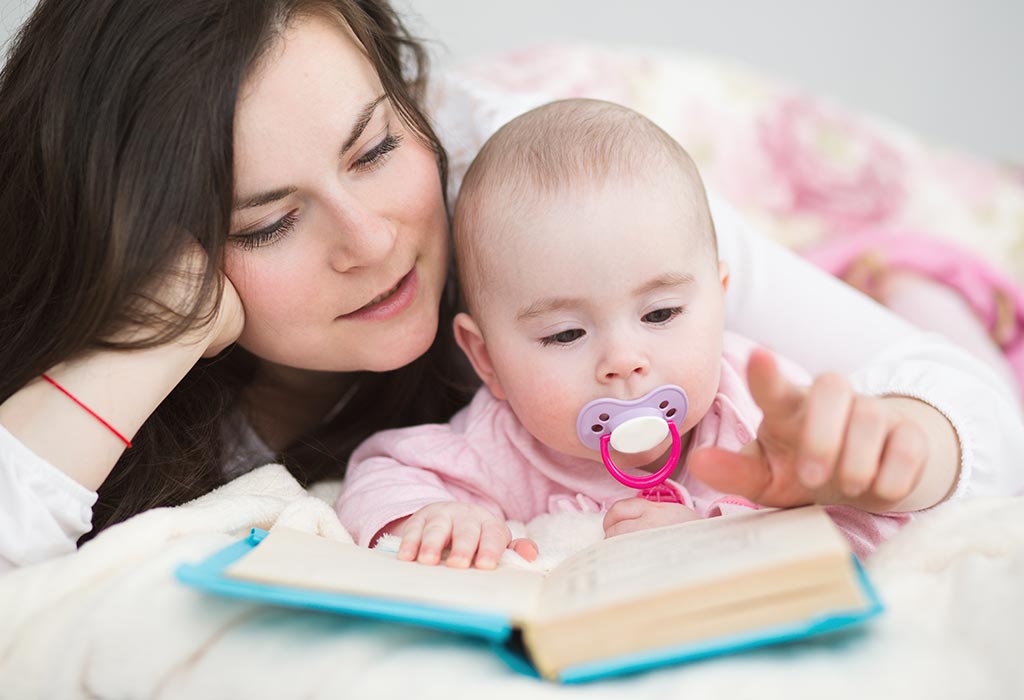
How to Do This Activity
Ensure that you read slowly, adding gestures and emotions. Encourage your baby to laugh or act surprised to make it more interactive. It’s good to choose books that are short, colourful, and have pictures. As babies tend to chew on books, hardcover books are specially designed so that they remain intact and do not tear.
Skills Developed
Six-month-old babies are taking little steps toward speech development. Your little one is grasping languages as she gets to hear them – reading helps develop this skill further. Reading helps with language, listening, and sensory development. The bright colours help your baby perceive pictures. Pictures with tactile components help in the development of sight and touch.
2. Clapping
Clapping is something your baby will do often. Clapping is fun, so encourage her to clap by clapping with her.

How to Do This Activity
When babies are around 6 months of age, they learn to clap. Clapping gives them immense joy, as it produces sound. You can show your baby how to clap, and make her clap. Take your baby’s hands in yours and teach her slowly. Clapping can be made more interesting by using rhymes or songs your baby likes moving to.
You can try:
Clap, Clap, clap, one, two, three,
Clap, clap, clap with papa and me!
Clap, clap, clap, four and five,
Clap, clap, clap as brother learns to dive!
Skills Developed
Clapping introduces babies to sounds, and adding music to the game introduces them to the world of rhymes.
3. Talking
Babies love to babble, and they find it thrilling when you respond. So, talk and listen to your baby.
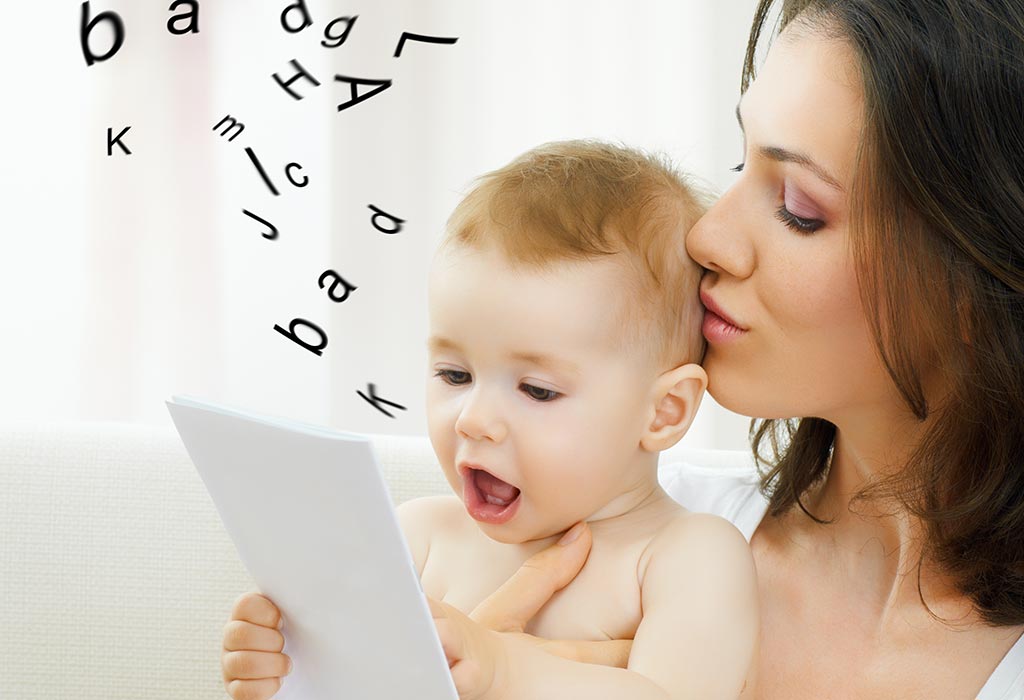
How to Do This Activity
Strike a conversation with your baby. When your baby babbles, respond to her with a smile. Point to your baby’s clothes and describe them. Explain to your baby what you are feeding her, or what she’s surrounded by. Babies love this, as it encourages them to talk.
Skills Developed
Talking helps enhance a baby’s language and listening skills.
4. Singing
Singing a lullaby has been a practice for ages. Sing to your baby and introduce her to the world of music.
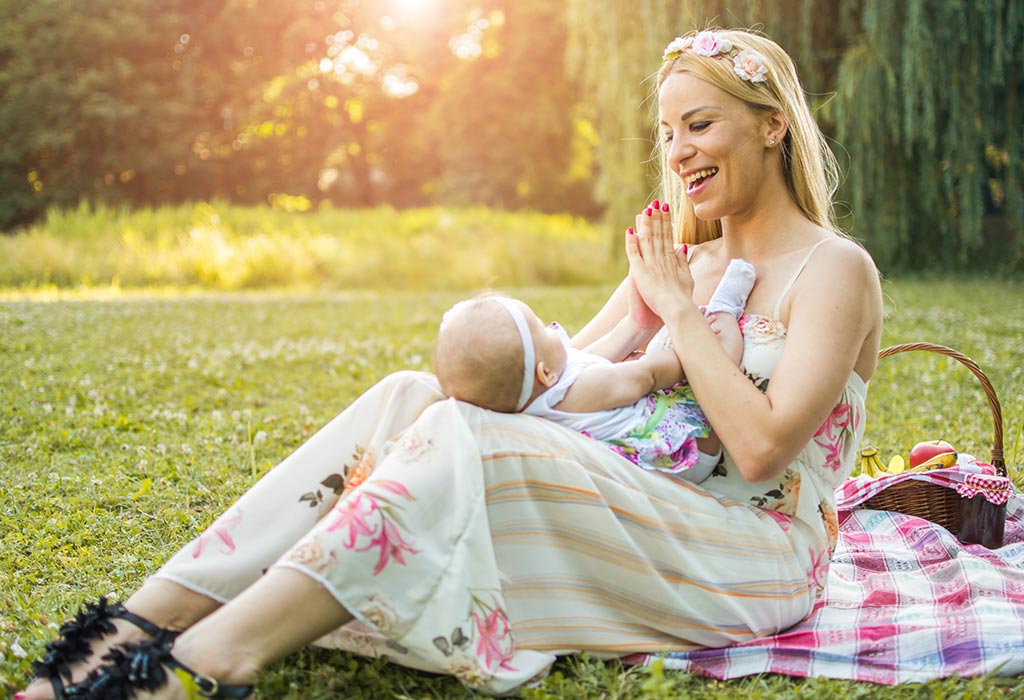
How to Do This Activity
Make up any song and sing it to your baby as a lullaby. You need not only do this at night; sing to her while giving her a bath or while feeding her. You can make a song out of the activity you are doing as well. For example, when you’re changing her, you can sing, “Now, I’m going to change your clothes”.
Change your voice to make it animated. Try different options so that the baby learns auditory discrimination.
Skills Developed
Singing and using different sounds enhances a baby’s sensory appeal and introduces auditory discrimination.
5. ‘Peekaboo’
‘Peekaboo’ is a fun game that makes babies laugh and light up with joy on seeing the parent’s face suddenly pop up.

How to Do This Activity
This activity can have variations. The most popular ones are as follows:
- Covering Your Face: Cover your face with your hands or a cloth and hide from your baby. After a while, drop the cloth or put your hands away and say, “peek-a-boo!” Your baby will try to pull your hands away from your face after watching you a few times and squeal with laughter.
- Hide Behind a Chair or a Sofa: You can also hide behind a chair, the sofa, or a curtain and suddenly re-appear by saying, “peek-a-boo”.
You can improvise using other objects as well. Hide a book, a toy, or any other object under a blanket and make it partially visible. Then, ask the baby to find the object. “Where is it? Come find it!” As the baby masters this skill, you can graduate to hiding the object altogether and encouraging her to find it.
Skills Developed
This activity helps in the baby’s fine motor skill development. It also teaches the baby object permanence – a concept that objects or people exist even when you can’t see them. This activity helps develop this cognitive concept in babies.
6. Flying
Babies love being cuddled, moved around, and played with. Lifting your baby up and making her fly is an excellent activity.
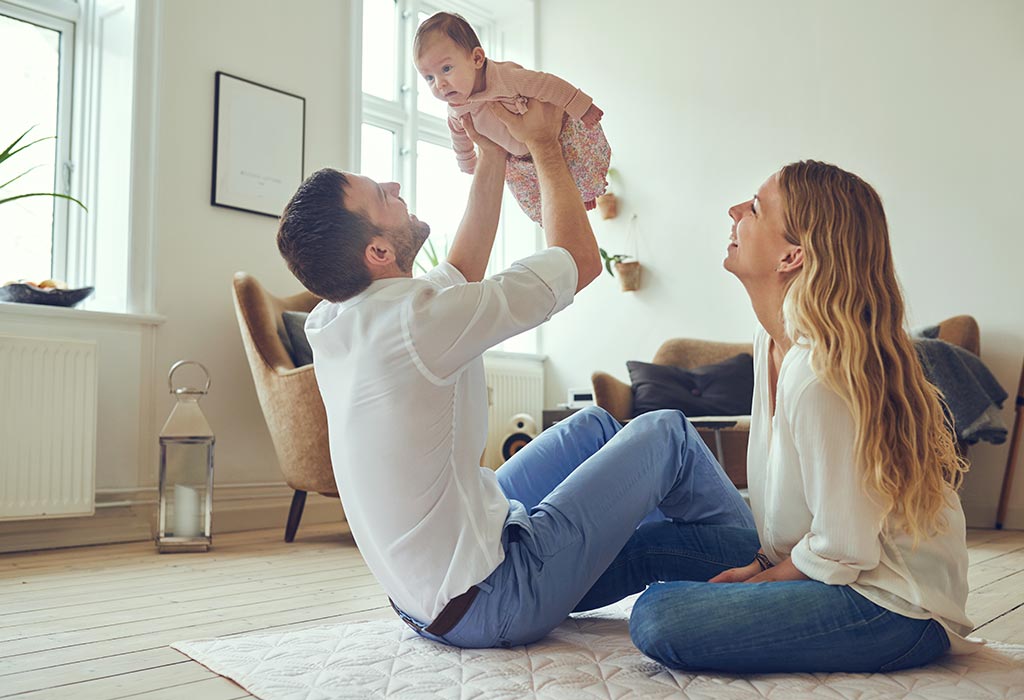
How to Do This Activity
Put your baby down on your lap, on her belly. Hold the baby with both your hands. Make sure you support the mid-section carefully. Lift your baby gently and move her up and down and back and forth, just like a bird or an aeroplane. Your baby will squeal with laughter, owing to the surprise factor of moving around in various directions.
Skills Developed
Babies look around with a renewed perspective. It helps with body movement and stimulation.
7. Follow the Leader
Babies love imitating people they adore, and your baby would love to imitate you!
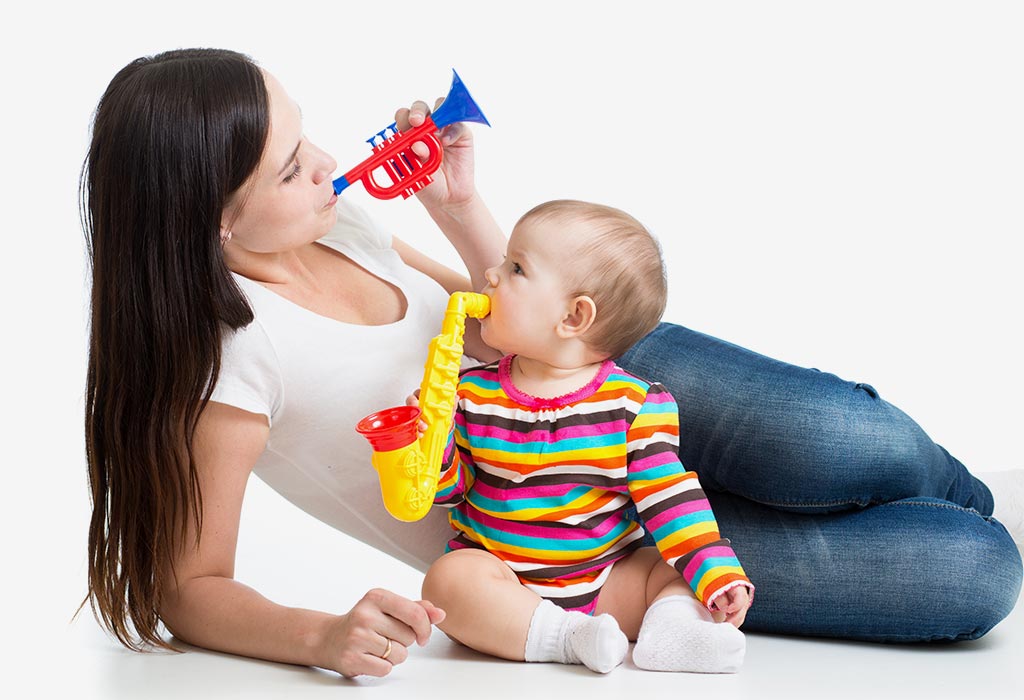
How to Do This Activity
Start with an activity your baby can copy easily – waving the hand up and down, clapping, closing your eyes, and opening your eyes. Encourage your baby to watch and imitate you. You can add more actions and watch your baby’s reactions to them.
Skills Developed
This activity helps develop memory power and helps the baby understand how imitation works.
8. Kicking
As your baby grows, her playtime will increase and she will enjoy physical activities more and more. So, it’s a good idea to integrate the baby’s physical and sensory development by way of a fun activity.

How to Do This Activity
Take some pieces of colourful cloth. Tuck them under the sofa in such a way that the cloth pieces hang down like a curtain. Put the baby on her back, with her feet against the cloth pieces. The baby will start kicking the cloth with her feet. To make the game a little more challenging, move her a little further from the cloth pieces.
Skills Developed
Your baby will learn sensory integration, chin tucking, body awareness, and the cause-and-effect phenomenon.
9. Sit-Ups
Muscle strengthening is important for your growing baby. Baby sit-ups can help your baby tone her muscles.
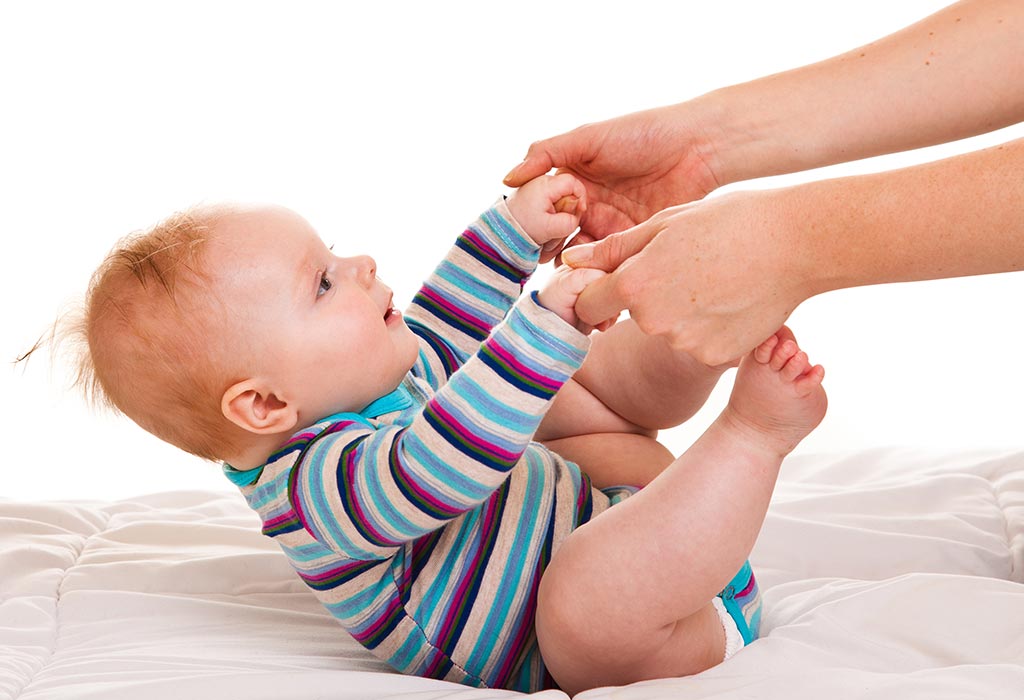
How to Do This Activity
If your baby’s head control is good, you can lay her on her back. Place your hands under her, and slowly guide her to come up in a sitting position. As the baby uses her muscles to come up, you can hold her hands and make her do sit-ups.
Skills Developed
This activity enhances your baby’s motor skills and head control.
10. Bouncing on the Leg
Moving back and forth is thrilling for babies. They love the movement, especially when they are on their mother’s lap.
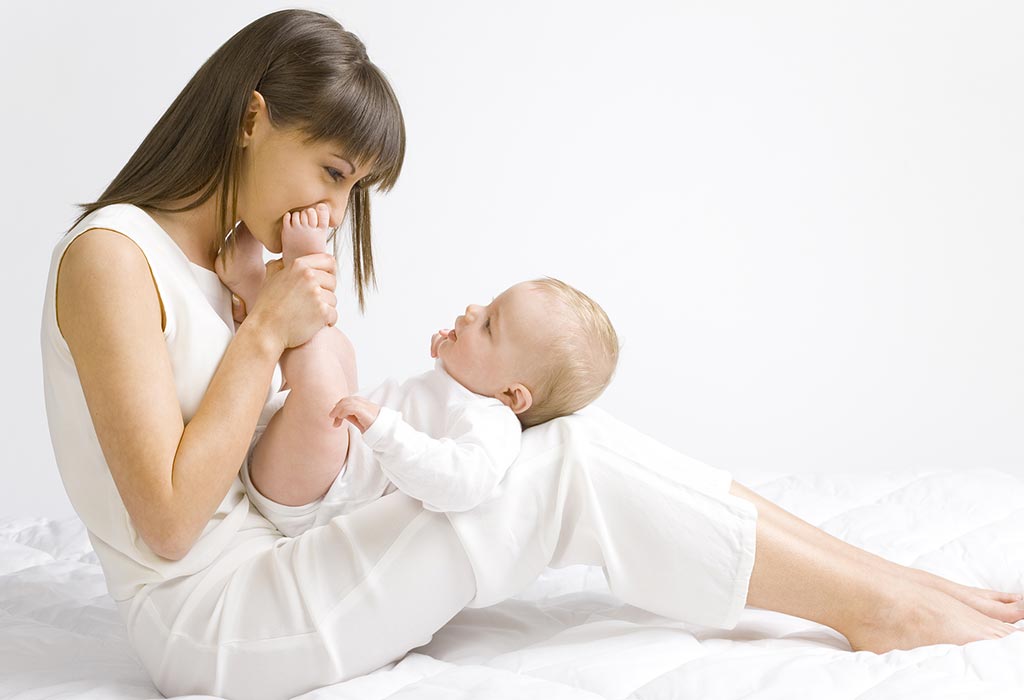
How to Do This Activity
Make your baby sit on your lap, facing you. Bounce your baby up and down. You can sing to her as you play with her. Make her go up and down at varied paces – it will make her laugh and giggle, and even ask for more.
Skills Developed
This game helps in body movement.
11. Blow Bubbles
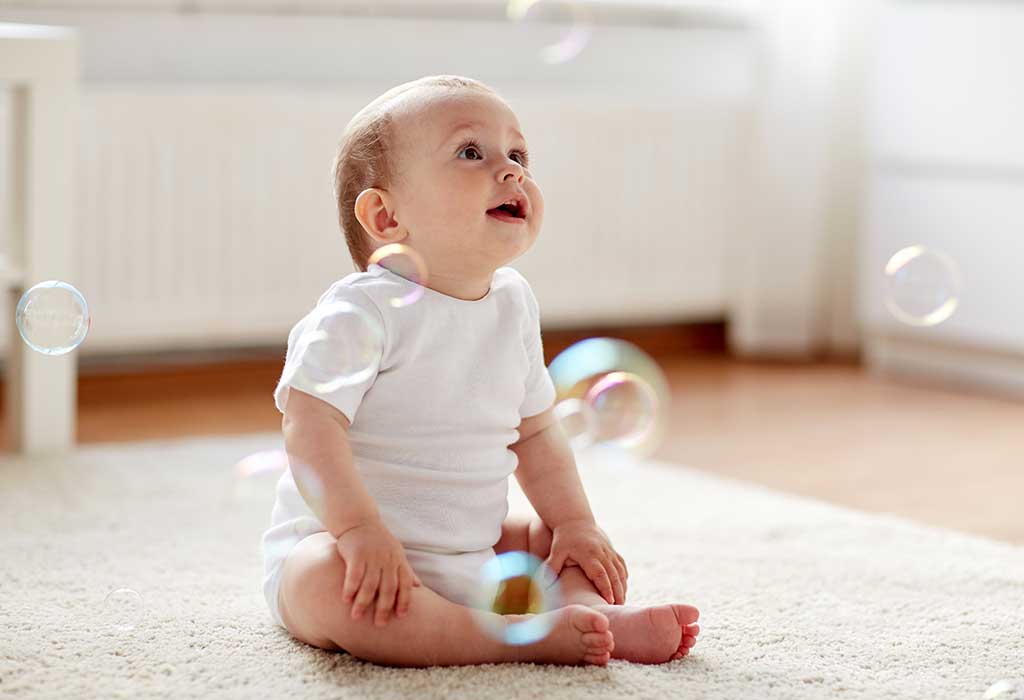
Babies at 6 months can see far enough to focus on bubbles, and those shiny soap bubbles can prove to be quite entertaining for them.
How to Do This Activity
You can go for store-bought bubble liquid. Simply blow the bubbles around your baby and watch her become enchanted with all the translucent spheres around her.
Skills Developed
Blowing bubbles can help develop your child’s vision and concentration.
There are various sensory activities for 6-month-old babies that you can try to boost the development of your little one. Playtime can be fun and effective by introducing babies to activities that act as catalysts in their holistic development as they crawl and walk into celebrating their first birthday.
Resources and References: Flo









